Nursery tags can be confusing. When you’re thinking about the size of conifers — trees with cones and needle- or scale-like leaves — there’s the 10-year size, the ultimate size and the pruned size. Does the variety in question grow vertically or horizontally? Different cultivars of the same species can grow to vastly different sizes, and conifers planted in containers may grow more slowly than those planted in the ground. Let’s make some sense out of it all so that you don’t encounter unpleasant garden surprises in the coming years.
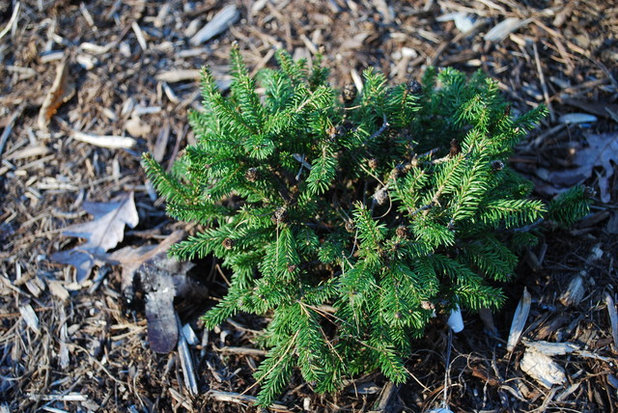
Jay Sifford Garden Design
Types of Tree-Form ConifersThe American Conifer Society (ACS) has developed sizing criteria to simplify this sometimes-confusing topic. Doing research on the front end will help you choose the right species and variety for your particular space.
Miniature. The ACS defines miniature conifers as those that grow less than 1 inch per year in any direction (height or width) and have a 10-year size of less than 1 foot in any direction. Variable growth rates can occur due to culture, climate and geographical differences.
Norway spruce (
Picea abies, USDA zones 2 to 7; find your zone) can easily reach 80 feet tall, growing up to 12 inches per year. However, cultivars that result from genetic abnormalities, called witches’ brooms, may grow just 1 inch per year, such as the
P. abies ‘Pusch’ seen here. Understanding the size difference between cultivars of the same species is crucial when designing a conifer garden for long-term success.
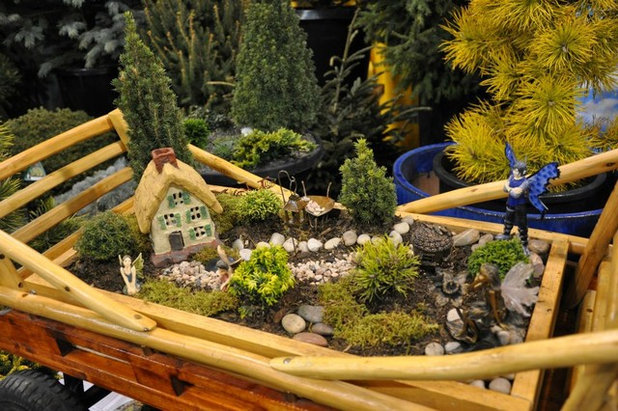
PC Landscaping
Miniature conifers have gained popularity in fairy gardens and hobby railroad landscapes. Their diminutive size and slow growth rate means they can be enjoyed indefinitely in these settings. They are also well suited for rock and alpine gardens.
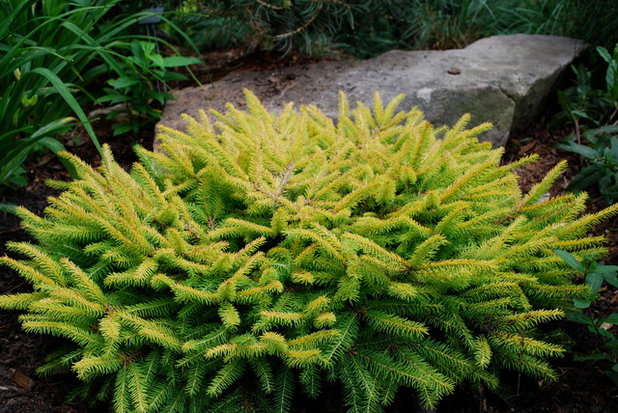
Jay Sifford Garden Design
Dwarf. Dwarf conifers are defined by the ACS as those that grow from 1 to 6 inches per year and have a 10-year size of 1 foot to 6 feet in any direction. This Vermont Gold Norway spruce (
P. abies ‘Vermont Gold’, zones 3 to 7) has an expected growth rate of 2 to 4 inches per year, with a 10-year size of less than 3 feet
tall or wide.
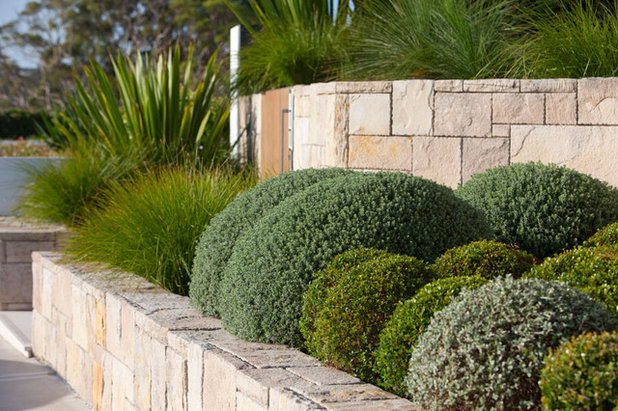
Secret Gardens
Dwarf conifers, such as Little Gem Norway spruce (
P. abies ‘Little Gem’, zones 2 to 8) and dwarf Japanese cedar (
Cryptomeria japonica ‘Globosa Nana’, zones 2 to 7), both shown here, are useful as foundation plantings, as container plantings and incorporated into narrow beds between hardscaping. Properly chosen and sited, they will not outgrow their usefulness.
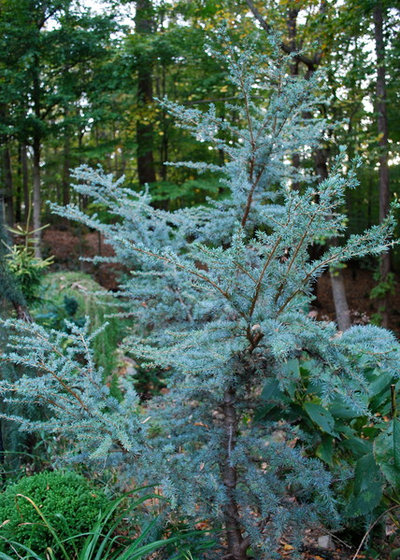
Jay Sifford Garden Design
Intermediate. These conifers grow from 6 to 12 inches per year and have a 10-year size of 6 to 15 feet in any direction. Most of the tree-form conifers frequently available in nurseries fit into this category. Horstmann blue atlas cedar (
Cedrus atlantica ‘Horstmann’, zones 6 to 9), seen here, reaches a height of 8 to 10 feet in 10 years.
Intermediate conifers are suited for most urban yards and courtyard gardens, where their larger relatives would appear out of scale or worse, would be destructive to the surrounding hardscape.
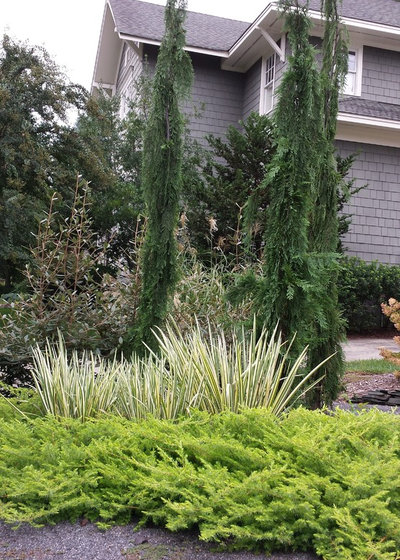
Jay Sifford Garden Design
These intermediate-growing Van Den Akker Alaskan cedars (
Chamaecyparis nootkatensis ‘Van Den Akker’, zones 5 to 8) are a good choice for a small urban courtyard. This tree can be expected to grow to a 10-year height of 15 to 20 feet, putting on 6 to 10 inches of growth per year. Additionally, this conifer stays less than 2 feet wide.
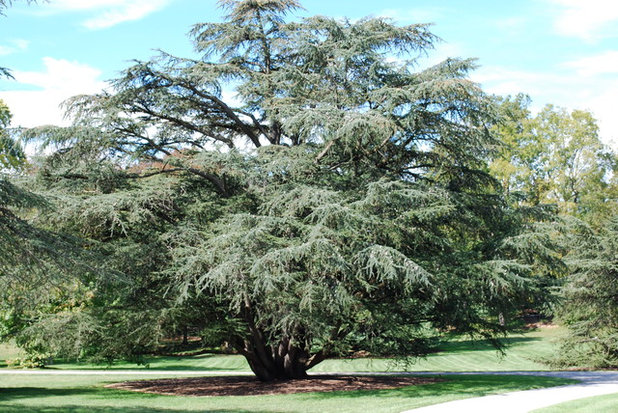
Jay Sifford Garden Design
Large. These conifers are defined by the ACS as those that grow over 12 inches per year and have a 10-year height of over 15 feet. Blue atlas cedar (
Cedrus atlantica ‘Glauca’, zones 6 to 9), seen here at Longwood Gardens, attains an ultimate height of over 50 feet. I have encountered several gardeners who planted this when they should have instead planted Horstmann in their small courtyard gardens.
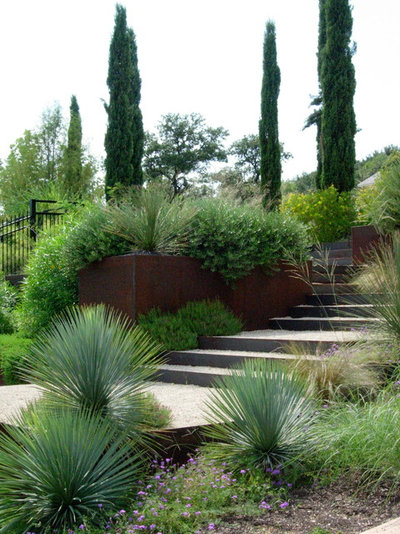
D-CRAIN Design and Construction
Large conifers are suited for large, expansive spaces where they can play the role of the strong, silent type from a distance. Notice how this installation of Italian cypresses (
Cupressus sempervirens, zones 7 to 10) in the distance provides just the right vertical element to contrast a variety of plants in the foreground, effectively finishing this vignette. The eventual height of this cypress, up to 70 feet, would make it a poor choice for small spaces.
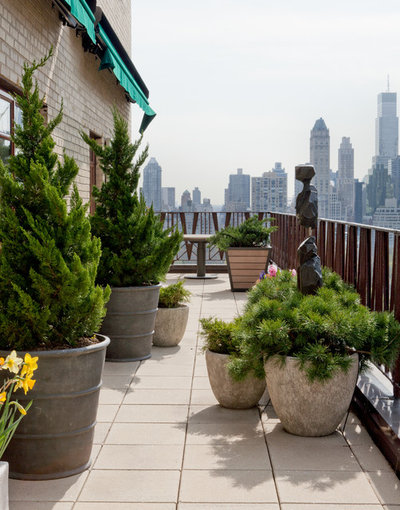
Wettling Architects
Potted trees. Growing tree-form conifers in pots can slow down the growth rate so that even a larger-growing tree can be enjoyed for many years in a small space before being planted in the ground.
Larger-growing trees can frequently be root pruned and candled to maintain a more manageable size. Root pruning consists of removing the tree from its pot and trimming some, but not all, of the feeder roots. This will limit the plant’s nutrient uptake and will slow the plant’s growth rate. Candling involves removing new growth to limit the plant’s ultimate height and width. Japanese gardeners and bonsai enthusiasts have practiced these techniques for centuries. A hundred-year-old tree growing in a small bonsai pot is an amazing sight.
Be advised that cutting into the old wood of a conifer may permanently compromise the tree’s natural form. Candling is best done before the new growth is fully mature.
See how to grow conifers with style in containers
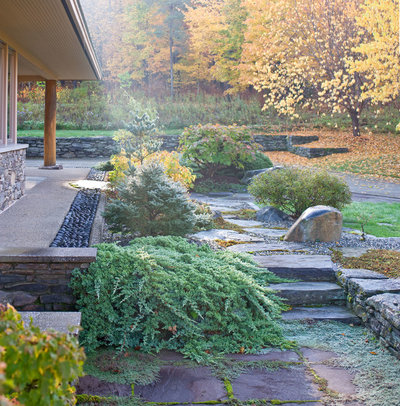
Cynthia Knauf Landscape Design Inc
Shrub-Form ConifersThe list of shrub-form conifers is seemingly endless. Led by junipers, these conifers generally grow to a more predictable and manageable height. Many remain low, some less than 1 foot tall, and spread to a width of 3 to 5 feet, effectively becoming a ground cover. Others can reach an eventual height of 8 feet or more, so proper choice and placement are paramount.
Shrubby conifers can make a stunning focal point, as shown in this garden. The properly sited dwarf Japanese garden juniper (
Juniperus procumbens ‘Nana’, zones 4 to 9) commands attention as it cascades over a low wall.
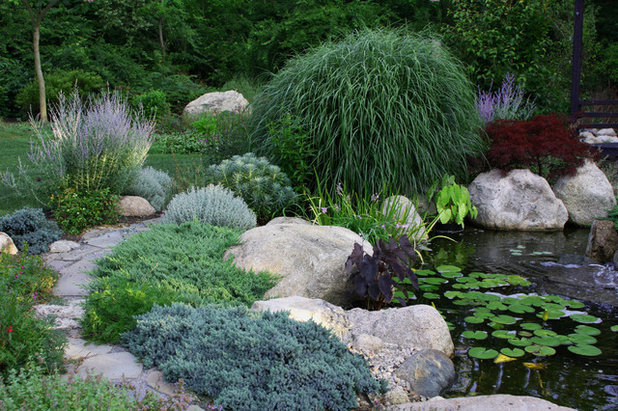
Amy Martin Landscape Design
In this garden another dwarf Japanese garden juniper, along with a blue star juniper (
Juniperus squamata ‘Blue Star’, zones 4 to 8), completes the composition by commanding attention in the foreground.
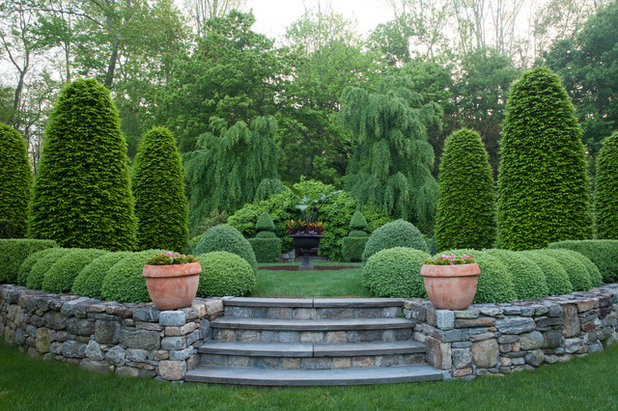
Oliver Nurseries
Research combined with thoughtful design can ensure an easily managed and aesthetically pleasing garden that will be enjoyed both now and well into the future.
More:Have Acidic Soil in Your Yard? Learn to Love Gardening Anyway
More Houzz guides to designing with foliage





